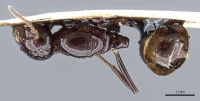Crematogaster augusti
| Crematogaster augusti | |
|---|---|

| |
| Scientific classification | |
| Kingdom: | Animalia |
| Phylum: | Arthropoda |
| Class: | Insecta |
| Order: | Hymenoptera |
| Family: | Formicidae |
| Subfamily: | Myrmicinae |
| Tribe: | Crematogastrini |
| Genus: | Crematogaster |
| Species group: | ranavalonae |
| Species: | C. augusti |
| Binomial name | |
| Crematogaster augusti Emery, 1895 | |
Nothing is known about the biology of Crematogaster augusti.
Identification
A member of the Crematogaster ranavalonae-group
Hosoishi (2015) - Emery’s original description was based on a single queen. Our collections are limited to worker specimens, but two unique features are found in the type. First, the propodeal spines are not developed, as they are in the queen of Crematogaster agnetis from Madagascar (Blaimer 2012a). Second, the body surface appearing smooth and shiny. The taxonomic status will remain uncertain until nest series become available.
Distribution
Latitudinal Distribution Pattern
Latitudinal Range: -0.5° to -0.5°.
| North Temperate |
North Subtropical |
Tropical | South Subtropical |
South Temperate |
- Source: AntMaps
Distribution based on Regional Taxon Lists
Indo-Australian Region: Indonesia (type locality).
Distribution based on AntMaps
Distribution based on AntWeb specimens
Check data from AntWeb
Countries Occupied
| Number of countries occupied by this species based on AntWiki Regional Taxon Lists. In general, fewer countries occupied indicates a narrower range, while more countries indicates a more widespread species. |

|
Estimated Abundance
| Relative abundance based on number of AntMaps records per species (this species within the purple bar). Fewer records (to the left) indicates a less abundant/encountered species while more records (to the right) indicates more abundant/encountered species. |

|
Biology
Castes
Nomenclature
The following information is derived from Barry Bolton's Online Catalogue of the Ants of the World.
- augusti. Crematogaster augusti Emery, 1895h: 31 (footnote), pl. 2, figs. 19, 20 (q.) INDONESIA (Sumatra).
- Type-material: holotype (?) queen.
- [Note: no indication of number of specimens is given. Hosoishi, 2015: 73, says the description was based on a single queen.]
- Type-locality: Indonesia: Sumatra, Marang (no collector’s name).
- Type-depository: MSNG.
- Combination in C. (Oxygyne): Emery, 1922e: 157.
- Status as species: Emery, 1922e: 157; Chapman & Capco, 1951: 100; Bolton, 1995b: 148; Hosoishi, 2015: 72.
- Distribution: Indonesia (Sumatra).
Unless otherwise noted the text for the remainder of this section is reported from the publication that includes the original description.
Description
Type Material
- Holotype, queen, Marang, Sumatra, Indonesia, Museo Civico di Storia Naturale, Genoa; examined by Hosoishi, 2015: 72.
References
- Emery, C. 1895i. Voyage de M. E. Simon dans l'Afrique australe (janvier-avril 1893). 3e mémoire. Formicides. Ann. Soc. Entomol. Fr. 64:15-56. (page 31, (footnote) pl. 2, figs. 19, 20 queen described)
- Emery, C. 1922c. Hymenoptera. Fam. Formicidae. Subfam. Myrmicinae. [part]. Genera Insectorum 174B: 95-206 (page 157, Combination in C. (Oxygyne))
- Hosoishi, S. 2015. Revision of the Crematogaster ranavalonae-group in Asia, with description of two new species (Hymenoptera, Formicidae). Journal of Hymenoptera Research 42, 63-92.
References based on Global Ant Biodiversity Informatics
- Blaimer B. B. 2012. Untangling complex morphological variation: taxonomic revision of the subgenus Crematogaster (Oxygyne) in Madagascar, with insight into the evolution and biogeography of this enigmatic ant clade (Hymenoptera: Formicidae). Systematic Entomology 37: 240-260
- Blaimer, B.. "Untangling complex morphological variation: taxonomic revision of the subgenus Crematogaster (Oxygyne) in Madagascar, with insight into the evolution and biogeography of this enigmatic ant clade (Hymenoptera: Formicidae)." Systematic Entomology 37 (2012): 240-260.
- Chapman, J. W., and Capco, S. R. 1951. Check list of the ants (Hymenoptera: Formicidae) of Asia. Monogr. Inst. Sci. Technol. Manila 1: 1-327
- Emery C. 1895. Voyage de M. E. Simon dans l'Afrique australe (janvier-avril 1893). 3e mémoire. Formicides. Annales de la Société Entomologique de France 64: 15-56.
- Hosoishi S. 2015. Revision of the Crematogaster ranavalonae-group in Asia, with description of two new species (Hymenoptera, Formicidae). Journal of Hymenoptera Research 42: 63-92.
- Hosoishi S. and K. Ogata. 2009. A check list of the ant genus Crematogaster in Asia (Hymenoptera: Formicidae). Bull. Inst. Trop. Agr. Kyushu Univ. 32: 43-83.


